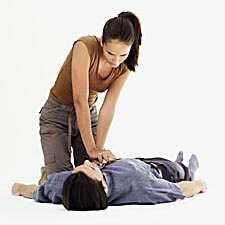Induced hypothermia after cardiac arrest improves survival chances and neurological recovery
- Category: News
- Posted On:
Earlier this year, 41-year-old Lonnie Acosta was grocery shopping on what seemed to be a normal day. What happened while he was in the store was anything but normal. Acosta went into sudden cardiac arrest and needed extreme measures to save his life.
One of the most important life-saving measures was taken before the paramedics arrived. Workers in the store noticed Acosta needed immediate medical attention. They placed a call to 911, then some shoppers began performing cardiopulmonary resuscitation (CPR), which proved vitally important to his survival.
“An enormous amount of credit goes to the bystanders who helped Lonnie,” says Acosta’s physician Dr. Glenn Kelley, a cardiologist at East Jefferson General Hospital (EJGH). “The sooner CPR can be initiated, the better the chance of survival. We recommend everyone in the community take a basic life-support class because you never know when a family member or someone you meet in life may need it.”

Cardiac arrest is when the heart stops beating and blood and oxygen flows cease. It can be caused by a heart attack, heart failure, rhythm disturbances, and other conditions. It becomes critical to resuscitate the heart quickly because the longer the brain and organs are deprived of blood flow, the greater the risk of suffering permanent damage or death.
In Acosta’s case, his heart was restarted with an automated external defibrillator (AED) and heart-stimulating drugs, but he remained unconscious. Kelley and the medical team at EJGH implemented a relatively new technique of inducing hypothermia that is gaining popularity among doctors.
Induced hypothermia is used in adult patients who have survived a cardiac arrest and have adequate circulation restored, but remain unconscious, says Beth Lacoste, a clinical nurse specialist at EJGH. In an effort to reduce the likelihood of permanent brain damage, the patient’s body is cooled rapidly to approximately 91 degrees Fahrenheit. Lowering the body temperature can help reduce oxygen demand and inflammation in the brain. Paramedics in our area are now equipped to start the cooling process even before the patient arrives at the emergency room. The treatment has had a positive impact on both survival and improved neurological recovery after cardiac arrest.
“The theory behind induced hypothermia is that when the brain is deprived of oxygen long enough, permanent tissue loss occurs through a complex cascade of physical and biochemical reactions,” Kelley says. “Lowering the body temperature can help attenuate these reactions in the brain that lead to ongoing damage in the 24 hours after a (cardiac) arrest.”
The goal is to maintain a state of hypothermia for approximately 24 hours. To induce hypothermia, medical staff commonly administer a chilled fluid intravenously and apply external cold sources to the skin. After the time frame has elapsed, the medical team slowly raises the body temperature back to normal.
Acosta responded well to the treatment and his condition improved. To treat the rhythm disturbance that caused his cardiac arrest, doctors implanted an internal defibrillator to provide a rescue shock to his heart if needed. He was discharged from the hospital within a week. Kelley says thanks to a quick call to 911, immediate CPR, use of an AED, and therapeutic hypothermia, Acosta’s life — and his brain — were saved.